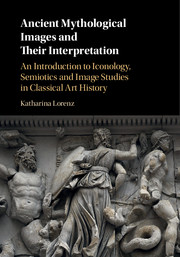 Ancient Mythological Images and their Interpretation
Ancient Mythological Images and their Interpretation Book contents
- Frontmatter
- Dedication
- Contents
- List of figures
- Preface
- The experiment: methods – images – objects
- ICONOLOGY
- SEMIOTICS
- IMAGE STUDIES
- 7 Introducing image studies
- 8 Image studies in action
- 9 Narratives of space and perspective
- 10 The study of mythological images as threesome – assessing the experiment
- Bibliography
- Index
8 - Image studies in action
from IMAGE STUDIES
Published online by Cambridge University Press: 05 August 2016
- Frontmatter
- Dedication
- Contents
- List of figures
- Preface
- The experiment: methods – images – objects
- ICONOLOGY
- SEMIOTICS
- IMAGE STUDIES
- 7 Introducing image studies
- 8 Image studies in action
- 9 Narratives of space and perspective
- 10 The study of mythological images as threesome – assessing the experiment
- Bibliography
- Index
Summary
Image studies interpretations proceed in three stages, devised to capture the functional aspects of the pictures and the logistics of their display. At the stage concerned with spatial design, the focus is on the physical set-up of the picture. In the second stage, which addresses iconography, the physicality of display is under scrutiny, along with how motifs are combined and subsequently experienced. The third stage explores historical dimensions, with a focus on space and perspective as modelled in and shaped by the picture.
The Karlsruhe hydria: the pot as spin doctor
The hydria and its spatial design.
The Karlsruhe hydria stands out because of the arrangement of its two pictorial areas, the upper picture field and the lower frieze. This design also characterises two pieces attributed to the Meidias Painter himself, and hence seems indicative of this artistic circle (for example fig. 5.3). More commonly, hydriae are decorated with a picture or frieze on the frontal part of the shoulder, or a picture on the front of the body. A sizeable group of hydriae combine a shoulder frieze with a body picture on the front. Hydriae of the Camirus type display a frontal pictorial field with an all-around animal frieze. The specific composition chosen for the three Meidian hydriae is unparalleled and at the core of the strategies used to generate and transmit meaning here.
The viewer approach required by the Karlsruhe hydria, with its two picture areas, contrasts with that required by hydriae with a frontal shoulder frieze and body picture, a design popular in the later sixth and early fifth centuries BCE. The upper picture field on the Karlsruhe hydria resembles the traditional frontal shoulder frieze-picture of earlier hydriae because it has to be viewed from above. However, the design is modified: the picture field is extended below the side handles of the vessel (fig. 0.1). This trapezoid picture field requires a lower viewpoint. Where the earlier design of a shoulder frieze established a focal point at the centre front of the body of the vessel, here the picture field takes its viewers across the whole horizontal extension of the vessel.
While such extension can also be found on other contemporary hydriae (figs 8.1, 8.2), on the Karlsruhe hydria, the design is extended further, to include a frieze that runs around the whole vessel underneath the upper picture field.
- Type
- Chapter
- Information
- Ancient Mythological Images and their InterpretationAn Introduction to Iconology, Semiotics and Image Studies in Classical Art History, pp. 184 - 223Publisher: Cambridge University PressPrint publication year: 2016


